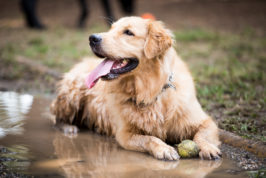Spotting the Signs of Early Arthritis
Arthritis is a painful and debilitating condition, and it doesn’t just affect people; it affects our furry friends too, so knowing the early signs of arthritis in dogs is essential.
Although it is often mistaken for a disease that only affects older dogs, younger dogs can also be affected by early-onset arthritis
Usually due to hip or elbow dysplasia, or after an injury. The good news is, if the signs of arthritis are spotted early, there are various options that can keep your dog mobile and comfortable for a good while longer, despite their condition. So, what are the early signs of arthritis in dogs? And how can it be diagnosed and treated?
What are the early signs of arthritis in dogs?

Arthritis is a condition that progresses gradually. While it can seem like there were no signs before a dog suddenly starts limping or struggles to stand, there are usually subtle early signs of arthritis that are easy to miss. Keeping our pooch pals as happy, healthy, and active as possible is important to us as pet parents, and spotting the signs early which can make treatment more successful.
So what are the early signs of arthritis?
Slowing down a bit
Chances are you used to struggle to keep up with your fit fur baby! If now they lag behind, you might think they’re being a bit lazy or just getting older. However, slowing down on walks can be an early sign that your dog’s joints aren’t as healthy as they used to be.
Stiff or sore after a rest
Did your dog used to bounce straight back, ready and raring to go on another walk after a rest? If you notice your dog seems a bit stiff, or has a limp for the first few steps after getting out of bed, this could also be an early sign of arthritis.
Avoiding steps
If your dog has suddenly become reluctant to jump up or needs more encouragement to climb the stairs, this could be a sign of early-onset arthritis. In particular this can be a sign of arthritis in a dog’s back. There are many household adaptations you can make to ease the strain on your dog’s joints. Check out some of the ways your home could be harmful to your dog here.
A change in behaviour
If your dog’s behaviour has changed or they have become subdued, grumpy, or even aggressive, the cause could be arthritic pain. Ruling in or out a source of pain is an important step in managing behaviour problems in dogs.
Licking at sore joints
Even if your dog still has plenty of energy and manages long walks or runs, there could still be underlying arthritis. A more subtle sign of arthritis is licking at the skin overlying a sore joint, sometimes causing bald patches over the carpus (wrist), elbow, stifle (knee), or hock.
Weight gain
Weight gain might seem like a strange sign of arthritis, but actually, it’s very common. If your dog is feeling a bit stiff or sore, they can’t exercise as much so they might gain a few extra pounds.
Limping
If your dog regularly limps during or after exercise, there might already be established arthritis. However, that doesn’t mean that there aren’t treatment options available to make them more comfortable and keep them moving.
What are the symptoms of severe arthritis in dogs?

If your dog has severe arthritis, they’ll probably be limping and stiff and may struggle to get up from lying down. However, there are other signs too. You might that their joints are swollen or hot to the touch. You might also notice that your dog has less muscle on one leg compared to another, or that the leg muscles seem to have wasted compared to how they used to be. Dogs affected by severe arthritis may still seem happy to exercise but will visibly struggle with mobility due to pain and stiffness.
How to diagnose arthritis in dogs
It’s time to make an appointment with your vet if your dog is showing symptoms that might suggest they have arthritis. Your vet will manipulate your dog’s legs and back, checking the flexibility and smoothness of movement in each joint. They’ll be watching your dog during the examination for any signs that the movements are uncomfortable.
If your vet suspects arthritis, they may recommend x-rays, which might require sedation or an anaesthetic. This is to rule out other conditions, especially if your dog has early-onset arthritis. Depending on what the x-rays show, your vet might suggest sampling the joint fluid, or referral to a specialist for a more advanced CT scan or an arthroscopy. However, these options may not be necessary for all dogs.
How do you treat arthritis in dogs?

The medical treatment of arthritis in dogs is two-fold. Firstly, supplements with ingredients like glucosamine, chondroitin, hyaluronic acid, collagen, green lipped mussel, vitamins, and fatty acids can help to improve the health of the joint. These ingredients provide the building blocks used for the repair and maintenance of cartilage and other joint tissue, and sometimes they contain natural anti-inflammatories, too.
The UK’s leading veterinary joint supplement brand has more information on choosing the joint supplement that’s right for your dog, and your veterinarian can also make a recommendation.
How to relieve arthritis pain in dogs
The second stage of arthritis treatment is pain relief, known as analgesia. Your vet will be able to prescribe various types of pain relief medications, depending on the severity of the pain and what suits you and your dog best.
How to manage arthritis in dogs
The treatment of arthritis is not just medical, lifestyle management is also really important. Arthritic dogs can benefit from controlled exercise, to keep them flexible. However, they mustn’t overdo it. Your vet can help you plan an exercise routine that will keep them moving, without doing extra damage. In addition, an arthritic dog may also benefit from hydrotherapy or physiotherapy, which will help correct muscle wastage and muscle pain with low impact exercise.
Another crucial part of managing arthritis is weight loss since less weight through the joints will be more comfortable for your dog. If you need help formulating a doggy diet, try contacting your vet team to see if they run a weight loss clinic.
Frequently Asked Questions
The best treatment of arthritis relies on a combination of joint supplements, pain relief, weight management, and exercise management. However, it’s important to understand that although we can manage the symptoms of canine arthritis, and even slow its progression, we can’t make it go away.
Just like in people, dogs seem to struggle more with arthritis in the cold winter months. Therefore, heat can be useful to help get the joint ready for exercise. Keeping the house warm, using warm beds, and even warming up joints before exercise can be helpful. Always be cautious with heat sources to make sure you don’t accidentally burn your dog and speak to your vet for advice if needed.
Too much exercise causes arthritic dogs to be more painful and increases inflammation and wear and tear on the joint. On the other hand, total rest in the long term will cause your dog to cease up, reducing their flexibility and muscle mass, and increasing their stiffness and weakness.
If your dog has arthritis, it is crucial to find a good balance where your dog has small amounts of low impact exercise to keep them mobile but is rested if signs of arthritis worsen. In other words, regular ‘little and often’ exercise is generally best, but may not suit all dogs. Your vet can help you decide on the right amount of exercise for your dog.
The sooner arthritis is spotted, the sooner treatment and management can be started. Joint supplements, controlled exercise, and weight management can go a long way to keeping arthritis under control. So, with early intervention, your canine companion can enjoy life to the full for years to come.




